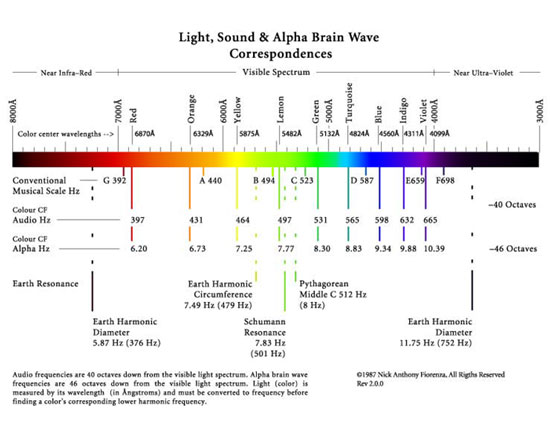Planetary Harmonics & Neurobiological Resonances – in Light, Sound, & Brain Wave Frequencies – Including the translation of sound to color
In this article you will discover:
– How to convert musical notes to color
– Musical notes and keyboard colors
– Play Pythagorean vs. Standard Scales
– Tuning a musical scale to Earth and Venus
– Planetary Harmonics for light-sound healing
– Natural versus man-made frequencies
– Schumann Resonances & Brain Waves

The Measurement of Light. Converting Audio Tones to the Visible Spectrum of Light – Color
Before getting into Planetary Harmonics and Bio-harmonic resonances, let us first explore the octave of visible light, that which the human eye sees, and its relation to sound. The octave of visible light, extending from the color red to the color violet, is forty octaves higher than the middle audio octave, that which you would hear on a piano keyboard. Light, however, is measured by its wavelength, whereas sound is measured by its frequency.
Frequency is a measure of how many waves occur in a given moment of time. The most common unit of measure for frequency is the Hertz (named after German physicist Heinrich Hertz). One Hertz = one cycle per second. A frequency of 60 Hertz means that there are 60 cycles occurring in one second. People with computers often hear of Megahertz (MHz) or Gigahertz (GHz) (106 or 109 hertz, respectively) when referring to how fast their computer memory or hard drive runs. The frequencies within the light octave are much faster than this.
If we were to raise middle C, which has a frequency of ~523 Hertz, by forty octaves (523 times to forty times), we would have a very high frequency of 5.75044581 x 1014 Hertz. That is 575 trillion cycles per second. Because of these unweilding numbers, light is measured by the length of a wave (space) rather than how many waves are occurring in a second. A higher frequency means that there are more waves occurring in a given amount of time, thus the waves become shorter as the frequency becomes higher. Thus, frequency and wavelength have an inverse relationship.
Waves of light are quite short. For example, the center frequency of the color green has a wavelength that is 0.0000005132 meters long (0.5132 x 10-6 meters). To make this easy, we measure visible light (and interatomic distances) in a unit called the Ångström (Å) (named after the Swedish physicist Anders Jonas Ångström). One Ångström = 1 x 10-10 meters (that is 0.1 nanometers). The colors of the visible spectrum are measured in thousands of Ångströms. As shown in the following chart, the visible spectrum of light, that which the human eye sees, extends from about 7800 to 7000 Å (red) to about 4000 to 3800 Å (violet). Also shown in the chart are the center wavelengths for each of the seven basic colors; their corresponding audio frequencies; and the location of the musical notes of an audio octave translated to the the visible spectrum.
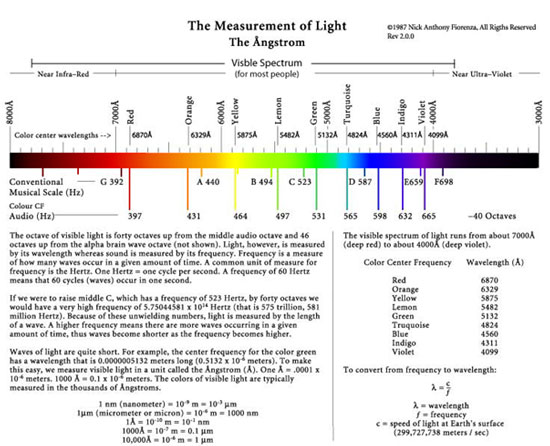
Converting Frequency to Wavelength

To convert a frequency to wavelength, we divide the “speed of light” by the frequency. Conversely, to convert a wavelength to frequency, we divide the “speed of light” by the wavelength.
To convert the middle audio octave to light (wavelength) we must first raise the note (frequency) forty octaves (frequency times to forty times).
Example: To convert middle A (440 Hz) to its corresponding wavelength in the visible spectrum, first we must raise 440 Hz forty octaves (440 times to forty times).
Note: This is the same as 440 x 240 (2 raised to the 40th power), or 440 x 1099511627776.
440 x 240 = 483,785,116,221,440 cycles/sec.
Now we convert that frequency to wavelength (using the formula above). Thus, we divide the speed of light by that frequency.
Using 299,727,738 m/sec (the speed of light at Earth’s surface):
299727738 meters/sec divided by 483785116221440 cycles/sec = 6.19547249285e-07 meters
This is equivalent to 6195.4725 Ångströms, which lies in the orange area of the visible light spectrum.
Note: using the speed of light in air or the speed of light in a vacuum will yield slightly different results.
Thus, when we raise each note in middle audio octave by forty octaves we find its corresponding color harmonic. As shown in the chart below, the note G lies in the red area of the color spectrum. The note A raised forty octaves lies in the orange part of the spectrum. The note B lies in the lemon (yellow-green) part of the spectrum. The note C in the green band; the note D in the turquoise-blue band; and the note E lies in the violet band. Notice that the note F lies in the far violet area of the visible spectrum. This is near where the human eye range of color perception begins to drop off (typically at about 4000 to 3800 Ångströms, although unique to each person). The note F, when raised 39 octaves rather than forty octaves, lies in the far-red/ early infra-red area, near the end of visual perception in the red area (~7800 Ångströms). Because of this, the note F embraces the visible spectrum, and thus has some red and some violet.
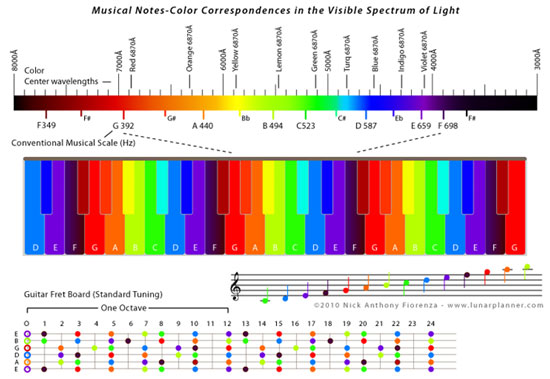
Piano Key Board and Guitar Fretboard in Color
Note: Translating the colors of visible light to a computer screen or to printed document is an approximation. Keep this in mind if you are using or printing the above chart for your personal use.
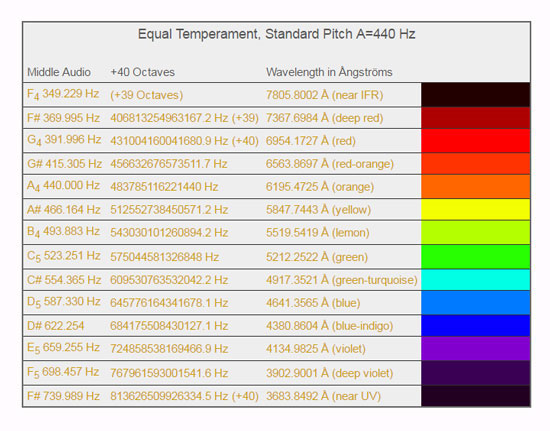
Play Music-Color Scales
To play a tone, hover over a color bar. You can play more than one tone at a time, but you can not replay the same tone until the tone finishes, which takes 5 seconds.
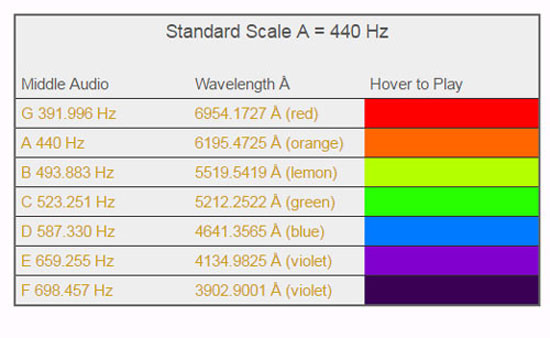
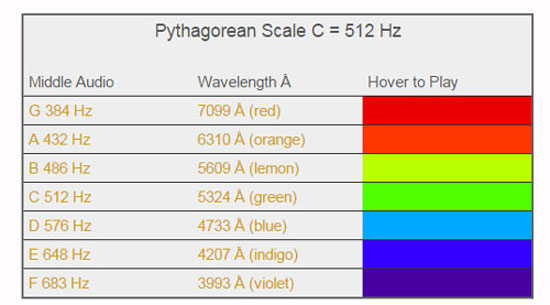
The Pythagorean scale
The Pythagorean scale is a “geometric scale” originally derived from the angles of geometric shapes; e.g., triangle, square, pentagon, hexagon, etc., which produce an F# scale. Mathematically it is based on intervals of fifths (3:2).Various scales can be derived by dividing an octave into intervals of “Tones” that have a ratio of 9:8 (1.125), and “Hemitones” that have a ratio of 256:243. All intervals are Tones, with the exception of E-F and B-C which are Hemitones. Note that in this Cmaj scale, C= 512 Hz (8 Hz raised 6 octaves) (2, 4, 8, 16, 32, 64, 128, 256, 512, 1024, 2048…). Notice also that its notes have a more even distribution throughout the color spectrum compared to our modern A=440 Hz Equal Temperament Scale. Try tuning your musical instrument to the Pythagorean scale (A=432 Hz), and feel how it sounds.
Although 440 Hz is the commonly recognized pitch for A4, adopted in 1939 by an International Conference held in London. Some orchestras in the UK and European countries use A=440 Hz and A=444 Hz. The New York Philharmonic and the Boston Symphony Orchestra use 442 Hz. Some orchestras use A=415 Hz for music composed around the baroque period. A4 was tuned to around 422.5 Hz (the frequency of Handel’s tuning fork) during the eras of Hayden, Mozart, Bach and Beethoven. There are many other pitches as well. Reference: PianoTuners.org.
Planetary Harmonics
The astrophysical parameters of a planet are, in part, that which create its astrological characteristic (psychophysiological resonance). An example chart of Earth’s Harmonic Spectrum is presented below. Earth’s astrophysical parameters are shown translated to their corresponding alpha brain wave frequencies, audio frequencies, and corresponding light (color) wavelengths.
The fundamental frequencies of a planet are derived from the planet’s astrophysical parameters such as diameter, circumference, rotational velocity, orbital period, perihelion/aphelion distances, orbital velocity, etc. These frequencies generally have very long wavelengths, thus they lie in the very low frequency (ELF) and ultra-low frequency (ULF) range. Planetary harmonics govern natural long-term biological growth patterns, monthly and yearly biological processes, and daily brain and psychophysiological function.
Like audible sound, brainwaves are measured in frequency, were as light is measured by its wavelength. The mid-audio octave is six octaves up from the alpha brain wave octave, and, as presented above, the visible octave of light (color) is 40 octaves up from the mid-audio octave.
When we think of a color of light, generally we are visualizing a narrow band of many frequencies (wavelengths) that comprise a single color or shade of color. In the chart shown above, the center frequency (wavelength) of each of the basic colors is shown, as well as their corresponding audio and brain wave frequencies. Also shown is the conventional musical scale, which reveals where each note lies with respect to the colors in the light spectrum.
The following chart shows the fundamental Earth harmonics in light, sound, and brain wave frequencies. All of these frequencies (and many more) create Earth’s unique “harmonic signature”.
“Spacial” astronomical parameters, such as the distance of a planet from the Sun or Earth, its diameter and circumference, to name a few, have harmonic resonances just like “time-related” parameters, like the orbital period of planet (its year); or its rotational period (its day). All of these parameters create a planet’s complex “harmonic signature”. That is why it makes little sense to say a planet resonates with one specific frequency. The harmonic signatures of all of the planets in our solar system, as well as a myriad of ever-changing resonances occurring between the planets, as well as those created by their ever-changing cycles with each other, produce our Solar System’s Grand Evolutionary Symphony in which all life on Earth evolves. This is the “harmonic environment” in which every biological rhythm breathes and evolves.
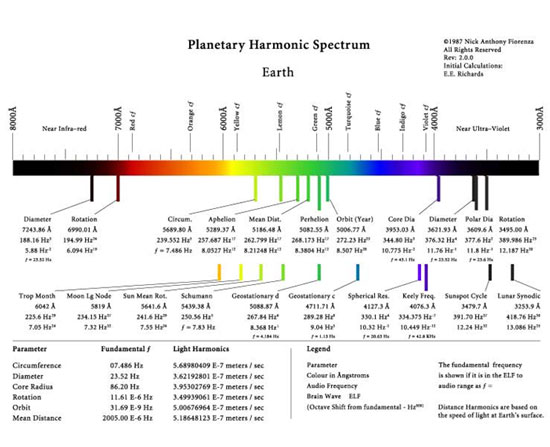
The Schumann Resonances
The 7.83 Hz. Schumann Resonance figure that many people hear about is a number made popular by researcher Robert Beck whose work on ELF signals, Earth resonances, and their affect on brain wave frequencies was presented at a U.S. Psychotronic conference and published in late 1970s. He reported that 7.83 Hz is a brainwave frequency often detected when psychics are in their intuiting mode. Others following his work proclaimed the Schumann Resonance to be 7.83 Hz., although this has led to some confusion as to the true nature of the Schumann Resonances (yes plural), and to the assumption that Earth herself resonates at this one frequency, which it does not.
In actuality, there are several frequencies between 7 and 50 Hertz that compose the Schumann Resonances. These frequencies start at 7.8 Hz and progress by approximately 5.9 Hz. (7.8, 13.7, 19.6, 25.5, 31.4, 37.3, and 43.2 Hz.). These resonances are not composed of fixed or specific frequencies any more than the collective mood of human surface consciousness is fixed. Changes occurring in these frequencies are quite normal and do not indicate anything out of the ordinary. All of these frequencies fluctuate around their nominal values. For example, the fundamental Schumann frequency fluctuates between 7.0 Hz. to 8.5 Hz. These frequencies vary from geological location to location, and they can even have naturally occurring interruptions.
These frequencies were reported by Schumann in 1952, he reporting the lowest in the group to be about 10 Hz. They were later measured by the National Bureau of Standards at Boulder Colorado in the 1960s where the 7.8 Hz nominal figure was confirmed along with the 5.9 Hz progressing overtones.
Nikola Tesla also measured and reported these frequencies and their power levels, predating the work of Schumann by 50 years. Tesla, however, reported the first four resonances only. They included the 7.8 Hz fundamental, a 14.1 Hz second harmonic, a 20.0 Hz third harmonic, and a 25.0 Hz fourth harmonic – all very close to the measurements made later. Source: The Transmission of Electrical Energy Without Wires As A Means Of Furthering World Peace . Published in Electrical World and Engineer, January 7, 1905.
The Schumann Resonances are the result of cosmic energy build-up within the cavity that exists between Earth’s highly conductive surface and the conducting layer in the upper atmosphere called the ionosphere.* This creates a world-wide lightning display of broadband electromagnetic impulses that fill this cavity and that act as the stimulus for the cavity to resonate. (This is another example of spatially created harmonic resonances.)
* A part of Earth’s upper atmosphere is ionized plasma caused by the Sun’s ultraviolet radiation.
This layer, the ionosphere, couples Earth’s outer magnetosphere with Earth’s inner neutral atmosphere.
The Schumann Resonances fluctuate around their nominal values because of slight variations in the size of the ionosphere and the crust of the Earth, both of which breathe due to variations in Earth’s magnetic field, solar influences and other deep space ionizing effects, and the lunar cycles.
The Schumann Resonances, thus, are also a part of the many frequencies that create Earth’s “harmonic signature”.
The 7.8 Hz. Schumann fundamental frequency is quite close to Earth’s 7.5 Hz. circumference harmonic (calculated using the speed of light at Earth’s surface). It is also close to 8 Hz., an ideal natural number from a mathematical perspective (see Pythagorean Scale above). Because of all of these factors, the 7.83 Hz. frequency, the 7.8 Schumann Resonance or an 8 Hz. frequency, had been proclaimed by some to be an ideal frequency to attune to, and that to electronically generate a frequency in this range may even protect us from unwanted harmful frequencies – a point upon which many tend to differ and which we’ll elucidate upon in the Light and Sound for Healing section below.
The fundamental 7.83 Schumann frequency is however our fundamental alpha brainwave frequency, and the cerebrospinal fluid (nearly 100% water) in the ventricular cavities in the brain resonates with and amplifies this signal. This is why it is essential to live in ways that are attuned to Earth, free from entraining man-made electromagnetic pollution.
To support our greatest wellbeing, and to make possible our evolution and spiritual awakening, we must allow ourselves (and our brainwave patterns) to breath in concert with mother Earth and with her natural cycles moment-to-moment. The Earth is a spherical receiver of cosmic energy (evolutionary intelligence) which directs our biological process and spiritual evolutionary unfoldment. The Earth re-radiates the cosmic information it receives from its core outward in complex long-wave signals. We receive these signals via our spinal columns and cranial structures (a vertical antenna system). The cranial cavity, the capstone to this antenna captures this information and re-focuses it to the pineal gland, a neuro-endocrine transducer in the center of the brain, where it is then transmitted (via the hypothalamus) as signals that direct the pituitary gland, the master control center of the brain. These signals are further distributed via the rest of the neurological system.
People living in dense man-made EMF frequencies (powergrids, cell phones, cell-phone microwave towers, TVs etc.), especially common to big cities, will have extreme difficulty being receptive to natural solar and other planetary resonances and their cycles that are responsible for our conscious evolution and optimal health. This is due to quantum-biochemical fact that intercellular and genetic communication occurs via light (electrons and photons), which is easily disrupted and distorted by external man-made EMF fields. There are also additional factors, such as the quality and purity of intercellular water, that make our quantum biochemical processes possible. Man-made electromagnetic radiation can cause everything from brain cell DNA damage to sever alterations in health, mood, emotional stability and behavior.

Radio frequency Antennas & Towers Across the U.S.
Signals in nature breath and meander. Only man-made signals are well-defined sign-wave frequencies. It is possible to entrain the brain with artificially generated signals in a matter of seconds, and at a cost. We are not intended to function at one specific frequency. Entraining ourselves with artificially generated frequencies for extended periods, whether 8 Hz or by the 50 and 60 Hz power fields and radio frequency pollution we live in, can be debilitating and is dangerous. It can create degeneration, disease, and mental, emotional, and physical disharmony and imbalance. Most importantly, it can keep us from receiving and integrating the cosmic intelligence provided by mother Earth in a harmonious way. That intelligence is responsible for our evolutionary awakening. It is more important now than ever to be attuned to Earth and the natural cycles of nature – our entire astronomical harmonic environment – for our optimal health, our mental, emotional and physical stability, and our spiritual awakening.
Planetary Harmonic Comparisons
Although there are many other parameters creating each planet’s “harmonic signature”, the following chart is a comparison of the four basic parameters of each of the primary planets: rotation and sidereal period (time), and circumference and diameter (space). Corresponding brain wave frequencies, middle octave audio frequencies, and light wavelengths are shown for each planetary parameter.
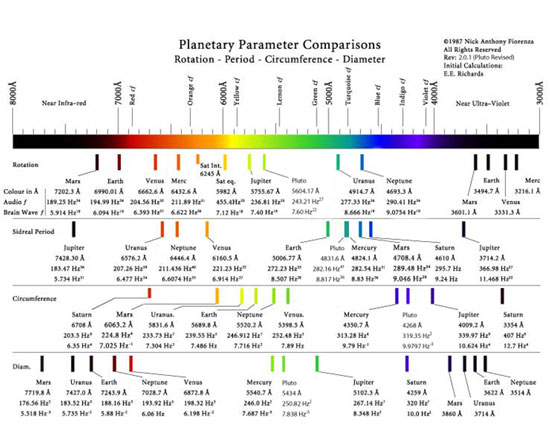
Notice the close resonance between Jupiter’s circumference harmonic and Pluto’s circumference harmonic, and between Jupiter’s diameter harmonic and Pluto’s diameter harmonic. Astrologically, Jupiter and Pluto work well together, this being one indicator of why this is so. The same holds true for Pluto and Mercury. Many interesting correspondences can be found when exploring planetary harmonics. Another example is the close resonance between Mercury’s rotation harmonic, and Neptune’s sidereal period harmonic.
A Fun Exploration for Musicians and Sound Healers
The following material reveals how to adjust the pitch of the conventional musical scale so it resonates to different planetary harmonics – in this case, Earth or Venus. Composing music in a pitch resonant to Venus, for example, can bring out an entirely new expression and an entirely new response from the listener.
The following two charts show musical octaves adjusted to the planetary harmonics of Earth and Venus. The first chart is more educational in nature. It shows the conventional musical scale, the Pythagorean musical scale, and a musical scale shifted to resonate with Earth’s mean circumference.
The Pythagorean musical scale is simply based on whole number progression of 8 Hertz as the fundamental frequency to create the note C. That is, 8 Hz. raised 6 octaves is 512 Hz. This drops the pitch of the conventional musical scale – from middle C being 523 Hz. to middle C being 512 Hz. Eight hertz is very close to the Schumann Resonance of 7.8 Hz.
The musical scale based on Earth’s circumference drops middle C yet further, down to 479.104 Hz.
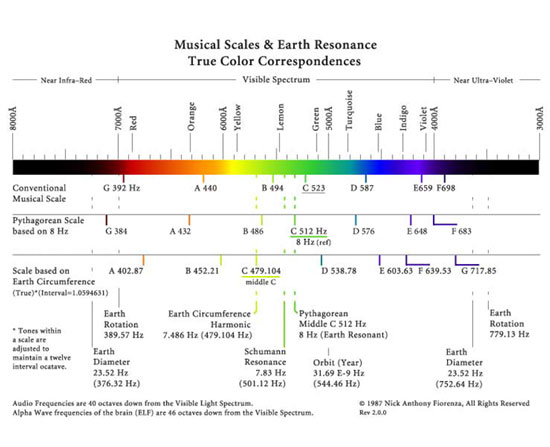
In Tune to Venus
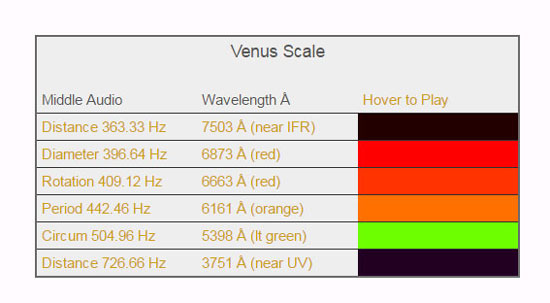
There are five scales in the chart below. The first one shows the conventional musical scale. Each of the other four are shifted in pitch to resonate with four different harmonic parameters of Venus.
The scale based on the circumference of Venus has the note C adjusted to this harmonic. The scale based on the diameter of Venus has the note G adjusted to this harmonic. The scale based on the rotation of Venus also has the note G adjusted to this harmonic. The scale based on the sidereal (orbital) period of Venus has the note A adjusted to this harmonic.
This last scale may be the easiest for musicians to explore for reasons discussed below. This scale raises the note A from the conventional 440 Hz. to 442.38 Hz. To compose music in this slightly higher pitch can provide a quite interesting experience. Because A is the primary note in this scale (resonant to the Venus sidereal period), it may be of interest to explore composition in the key of A, or with emphasis on A.
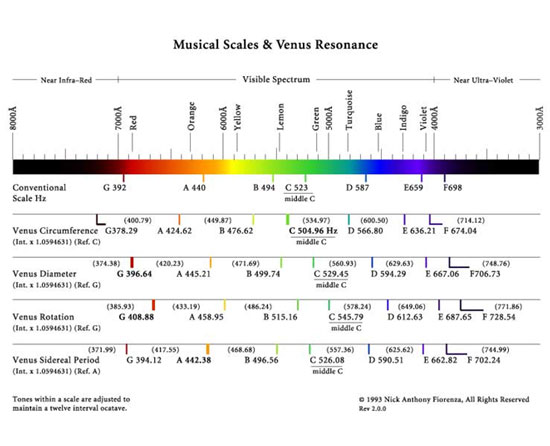
Changing the Pitch of a Musical Instrument
Obviously it is not possible to change the pitch on all musical instruments, but the pitch can be changed slightly on some reed and string instruments, and on some synthesizers. Because the pitch is shifted the least amount based upon the Venus Sidereal Period, it may be the easiest one for most musical instruments to easily accommodate.
More sophisticated synthesizers may provide the capacity to vary the pitch to accommodate the other scales, and some may even offer the ability to program the frequency of each note individually (which provides a means to create non-conventional scales with the planetary harmonics). Either way, there is the need to have a frequency readout of at least one note to adjust the pitch control of the synthesizer. If a synth does not have this feature, it is simple to connect a “digital frequency counter” for this purpose. (Ask your local electronics’ wiz to help). To adjust an acoustic instrument, simply use a microphone (and amp if required) fed into a “digital frequency counter”.
There are many ways to explore the use of Planetary Harmonics. Applying them in musical composition is a safe approach. However, caution should be exercised if
using any electronically generated frequency for a sustained period.
Planetary Harmonics in Light and Sound for Healing
An exploratory research in the 1980s using specific colors, sound, and geometry tuned to the planetary harmonics was extremely affective at stimulating mental, emotional, and physical response for healing purposes. The different harmonic parameters of one planet also have different effects as well. The use of specific frequencies in this more focused way should be explored only by those who have a thorough understanding of pioneering medicine; light-sound technologies; mental, emotional, and physiological correspondences; and the “healing crisis” process.
Because of the entraining capacity of single electronically generated frequencies (as described under Schumann Resonances), if they are used for sustained periods, they can trigger and hold a person in any number of psycho-emotional states. For example, specific frequencies can trigger or accentuate any “condition of weakness”. If a person has a thyroid condition and suppressed anger, certain frequencies may trigger this condition and enrage the person. If a person has a thymus (heart chakra) immune weakness and suppressed fear, sustained man-made frequencies can trigger and hold that person in extreme paranoia. (This type of entrainment already occurs due to the 50 and 60 Hertz electromagnetic fields people live in daily and the electronic devices they live with – including TV’s and computers.) For this reason, and when using frequencies for healing purposes, specific frequencies (especially in coordinated color and sound), should be used in sequences or progressions designed to bring a person completely through a healing crisis rather than simply trigger the condition, or worse yet, sustain it.
Whole brain and body resonance
Although the use of individual frequencies might be used for healing, brain and body coaching, etc. the healthy brain and body functions in wide bandwidth of naturally occurring resonances, not at some idealized frequency.
Remember, living in a pure and unadulterated environment free of entraining frequencies, attuned to Earth, the lunar rhythms, and to the other natural astronomical cycles of life, is one of the healthiest things a person can do.
The use of any of the information presented herein and any effects or conditions it may produce is the sole responsibility of the user. This material is offered for research and educational purposes only.
yogaesotericApril 4, 2017

